KTM factory enduro pilots Mike Lafferty and Russell Bobbitt choose radically different bikes for the same championship quest. We tested them back-to-back at the Rock Pile National Enduro in Cascade, Montana, to find out if bike imitates rider, if rider imitates bike or if KTM just wanted more models on the racetrack.I've never met two guys on the same team riding the same race series that ride so differently on different bikes but have nearly identical results. It's almost uncanny how unique these guys' riding styles and bikes are. The fact that they battle tooth-and-nail each weekend of the National Enduro Series tells you a lot about what true factory privileges provide. Under the orange tents, these two get to build what they want, and need, to win on. Their factory programs are so individualized they can start from different personalities and from different places on the map, build different bikes to their own specifications and end up in almost the exact same spot at the end of nearly every race day.Riding Mike Lafferty's KTM 400 XCR-W
Riding Mike's bike isn't really brainwork. Not at first, anyway. It's built to go fast, be smooth and to let its pilot go as fast at the end of a race as he does at the beginning. That's why he rides a four-stroke, after all. But once you get inside all of Mike's personal setup mods, remembering what's going on inside this ride really takes some thinking. Let's talk about riding it first!I love electric start. Mike's 400 has one and it works great. The bike hums with a soft growl, and the throttle response is crisp thanks to the ultra-clean and fast movement of the right grip. The carburetion is perfect and the 400's mellow growl follows in tune. The clutch pull is also nice, clean and ultra easy. Front brake feels good, too. It's strong but doesn't put me into the bar when I touch it. But what's wrong with the rear brake? It's basically pointing at the ground! Mike explains that's for a reason (duh, Jesse, everything on a factory bike is there for a reason).Mike often has to ride sitting down through tight sections and uses his brake for traction control on acceleration and while slowing down. He also, surprisingly, relies on his rear brake to stop. So, to get to the pedal while he's seated, it has to point down to eliminate the temptation to cook the fluid. That makes sense, even though I about piled into many a rock pile as I frantically looked for some rear slow-down action while standing.Lafferty's suspension is set up pretty nicely for a 180-pound magazine dork. It's sprung heavy (Mike's no baby) but combines light valving to let the fluid move before the springs kick in. This gives a supple-for-Mike (ridable for Jesse) bump compliance to the ride while maintaining a very tall feel. Again, Master Mike explained that when he's dancing around the immovable hard objects and weaving lappers inhabiting an enduro course, it's better for him to have a setup that keeps him tall and flickable rather than wallowy and down half the stroke. It's about combining turn performance and off-road plushness and it works perfect for Mike and not-so-badly for mortals.About the third time I overshot a corner on Mike's bike I remembered the team mentioning something about a slipper clutch. Maybe it was my frantic searching for a rear brake, but only now, as I headed toward a wayward Montana cow, did the slipper clutch thing make sense. I guess it's because the effect is subtle as slipper clutches go. The bike doesn't freewheel like a two-stroke, but the "slipping threshold"-fancy word I learned from the mechanic-does take the edge off deceleration and allows the bike to track more stable. The front never dives from chopping the throttle and the rear rarely gets light. The bike is nearly level at all times: accel, decel, whatever.That stability is transferred into the power character of Mike's machine flawlessly. There is no herky-jerky engine pulse or snap. It's linear perfection and spans as much potential in any gear as you could ask for. The bike gets gobs of traction and refuses to tire you out. It's almost an automatic and can handle ultra-technical grass-track off-camber balance turns as easily as it goes point-to-point in a flash.The number two bike has a lot of fancy factory tuning and personal modifications done to it. But the best part of this bike for guys like us is the wonderful 400 motor (that is almost completely stock-keep reading). The delivery will not, under any circumstances, scare the crap out of you. It makes awesome power in all the right spots. We've praised the stock 400 for months and this is why. He has an identical 450 race bike, too. I rode both of them, and the power difference is only moderately noticeable. But after five hours of racing, I'm sure the difference is huge. And that's why Mike races the 400. He'd rather ride his 450. But he loves racing the 400. He even runs a trick mod to make it more usable in the slipper clutch.That's what guys and gals like you and me (did I just call myself a gal?) will notice while on Mike Lafferty's bike. But that's only half the story. The rest is what's put into the bike.How It's Made: Mike's 400 Harkening Back To The RFS
Mike is fanatical about his throttle action. A G2 Ergonomics throttle cam system plays a big role in delivering an ultra-clean pull. On the 400, the throttle cam ratio is served up stock, with the biggest benefit coming from G2's smooth running throttle tube which floats over the bar on two points of contact (rather than a traditional throttle tube's full-length drag).In the saddle the riding position is fairly normal. His 999 Renthal Twinwall bar is low, but the custom-milled spacers under his KTM SXS bar mounts elevate it to a normal height. He runs a Magura clutch master cylinder setup from older KTM models because he likes the lever shape of the Magura and the team can fine-tune the lever feel thanks to Magura offering multiple master cylinder piston bore sizes. (The smaller the bore size, the easier the pull and more progressive the "feel" of engagement is).More unique parts at the hands are the grips and Boyesen Shokout system on the clutch side. Mike uses the "suspension" of the Shokout to fight off late-race fatigue and wrist pain. And his specific choice of MSR grips are the only ones he can't wear through in a race. Rounding out the cockpit is a Selle Dalla Valle custom Italian seat.A Factory Connection-tuned KTM SXS 48mm WP fork handles the front duties while a stock '09 XC-W rear shock (also tuned by FC) works the rear.It's hard not to notice the amount of protection on Lafferty's bike. His mechanic, Evan Yarnell, sums it up best: "Mike's a basher. He runs into and over a lot of stuff, so we put the biggest skid plate we could find on it."And the P3 skid plate is huge. But it's also hugely trick in its drilled-out carbon fiber glory. Cycra hand guards and deflectors, T.M. Designworks' chain guide, Enduro Engineering's hydraulic slave cylinder guard and a Zip-Ty Racing rear disc sharkfin make sure that nature gives and Mike keeps going.As far as motor mods go, there really isn't much inside Lafferty's ride. The 400 is simply a 400 (which is about four parts different than a 450). Air and fuel delivery, exhaust, clutch components and gearing are really all the team messes with. Most noticeable and trick on the bike's power delivery is the KTM Hard Equipment slipper clutch.Mike runs a host of carburetor mods and tricks (like removing the stock oil vent overflow tube from the carb and rerouting it down and out the bottom of the bike). But, according to the team, the time spent testing fuel pressure and the timing delay of the accelerator-pump circuit is measured in months. Mike requires more fuel pressure for quick response, but he also needs more timing delay off idle to handle the way he flutters the throttle in tight trails.They spend an equal amount of time on the hot gas getting out. FMF supplies pipes for the team, and on both Lafferty and Bobbitt's bikes they do some seriously custom stuff. For Mike, they give him a MegaBomb header custom built with just the right amount of holes inside the "bomb." How'd the FMF guys know what was the right amount? You guessed it: Mike and Evan's testing. During that testing, the duo asked for (and were given) a custom FMF Factory 4.1 muffler with spark arrestor insert. The muffler is 2 inches longer and has a smaller-diameter core than standard to increase backpressure. Both components broaden the bike's power, so Lafferty doesn't have to shift from chug to rev and can run one gear for a long, long time.Mike's 400 XCR-W Parts List****Motor
KTM HEQ slipper clutch (ML spec)
FMF MegaBomb header (custom ML spec)
FMF Factory 4.1 muffler with spark arrestor insert (custom ML spec)
KTM HEQ SXS billet clutch cover
KTM SXS radiator and hose kit, no thermostat
Twin Air filter and dust cover
Motorex Power Synt 4T 10w50 motor oil
Motorex Bio air filter oil
VP Fuels MS103Suspension
KTM HEQ SXS 48mm twin chamber fork, Factory Connection tuning
KTM stock '09 XCR-W shock, Factory Connection tuning
KTM HEQ SXS 20.5mm-offset triple clampsControls
KTM HEQ sXs billet bar clamps
Renthal 999 bar
Cycra hand guards and deflectors
GPR stabilizer
G2 Ergo throttle cam system
Magura hydraulic clutch assembly: 9.0 master cylinder and slave cylinder
Enduro Engineering stainless braided hydraulic clutch lineBoyesen Shokout grip assemblyProtection
P3 carbon fiber skid plate
T.M. Designworks chain guide
Enduro Engineering clutch slave guard kit
Zip-Ty rear disc sharkfinDrivetrain
Renthal ultralight front sprocket
Renthal oRG ultralight rear sprocket
RK GB520EXW chainBrakes
KTM sX front brake hose
KTM HEQ quick-pull caliper pin
Brembo '03 EXC rear caliper and pads
Enduro Engineering stainless steel rear brake line
Enduro Engineering solid rear brake rotorTires
Michelin MH3 80/100-21 front tire
Michelin S12 XC 130/80-18 or MH3 110/90-19 rear tire
Michelin Bib Mousse inserts front and rearMiscellaneous Chassis
KTM HEQ selle dalla Valle seat
Cycra Powerflow radiator shrouds
Russell Bobbitt
Riding Russell Bobbitt's KTM 250 XC
When comparing two versus four, it goes without saying that two will be easier to talk about. It's less complicated in every way. It even has fewer letters and is numerically half. It's no wonder the two-stroke is alive and well. Especially when it's the defending National Enduro Championship bike.There is no electric start on Bobbitt's 250 XC. In the days following this test I raced our Long Haul 250 XC with the E-start intact. I can say that I prefer the button to kicking any day but don't really expect it on a full-factory race bike that is as easy to kick as this 250. So I kicked it over and immediately forgot about my leg having to labor for that foot-and-a-half. (Suck it up, Ziegler, you're riding the champ's bike.)If I could have any factory mechanical talent in the world, it'd be jetting knowledge and skill. I can't describe how well Russell Bobbitt's bike runs. It's perfect and oh so cool. And that's just how impressed I was idling out of the pit area onto the trails.Out in the thick of it the character of Bobbitt's ride really comes out. This bike is an XC at heart but has an SX inside. The bike grunts and chugs where I ride and responds to my lack of opening the power valve well. It's tuned to run down low when the pilot needs it to and rip on demand. This is the perfect combination of KTM two-stroke bottom-end usability and long-revving top-end pull. In the middle you need to be on your toes and forward or the two-stroke snap will throw you back. But once you recognize where the power comes on, you can prepare accordingly. The best way to describe the two-faced nature of the bike is to imagine a two-stage flywheel. On the bottom, there is a heavy weight slowing the crank and delivering torque. Up top, the bike screams freely.Through the controls, Bobbitt's bike will clearly fit a wider range of riders. The Renthal 996 bar is great, and the Renthal Kevlar grips are tacky and wonderful. We've tested KTM's Progressive Handlebar Damping System (PHDS) and liked its ability to reduce the harsh impact pre-2009 KTM front ends delivered to our hands. On Bobbitt's '09 the system is used to mount the bar to the factory SXS top triple clamp which holds two stocky 52mm SXS fork tubes. This makes perfect sense with the setup inside that fork.Bobbitt is a self-admitted aggressive rider. He revs the bike high and rides with a lot of acceleration speed and hard braking. His suspension mirrors that with a pretty stiff feel. Even though I'm heavier and slower, the fork wouldn't get into the off-road plush zone I'd prefer to feel on small bumps, rocks and holes. Thank goodness for the added give of the PHDS. It knocked down the vibration from the two-banger and gave me some relief from a stiff factory fork.The front suspension wasn't bad. It just didn't soak up the little stuff with my speed. When I hit something bigger or went hot into some G-outs the bike was dreamy. Combined with the totally cool rear SXS shock, the front kept the bike from wallowing through all dips and never let the bike get sideways on rebound. These components have been tested and tested by the staff here at DR, and they almost always come back with comments just like these. The ability to keep a bike up in the stroke without feeling too tall and seemingly adhering the bike to the ground is a factory advantage.Interestingly, Bobbitt uses a 19-inch rear almost all the time. He's a big fan of the lightness and quick reaction time his 250 gives him and likes the stiffer tire out back. He doesn't worry about flats since he's running foam inserts. I'd like the added bump-absorption of an 18, but I'm not competing for a title.Russell Bobbitt's 250 XC is simpler than Lafferty's 400 (almost inherently). But it's not for a lack of personalization and trickness. Like Mike and Evan, Russell Bobbitt and his mechanic, Tony Hall, put a lot of time into testing parts that work.How It's Made: Russell's 250 Putting Some MX And SX Into The XC
Russell Bobbitt rides an XC unlike anyone else. That's why he's the defending champion. Surprisingly, major components like the cylinder, piston, bottom end and cases are stock.On top of the motor his mechanic Tony Hall bolts on an SX head for a harder hit of power. By combining an aggressive power-valve spring setup, a modified CDI box for a higher rev ceiling and a lighter flywheel than stock the voracious top-end is born.Countering the snap and speed is a modified power-valve height and a custom FMF Q silencer that is longer than standard with a spark arrestor. I tested his bike with the FMF Fatty pipe and Bobbitt was quick to say the Fatty was "pretty snappy"-thus the added inches to the silencer. They really like the hit of the SX-equipped motor, but the team wants a smooth transition between torque and rev. All of their 2-stroke pipes are specially made by FMF out of thicker gauge steel to handle Enduro abuse.A VForce 3 reed cage assembly adds to the pickup of power. A big deal for Enduro is ensuring you have the right transmission for the job. Bobbitt is completely happy with the stock XC transmission.Tony Hall (like Evan Yarnell) went to KTM's magical jetting school high in the Austrian Alps and his carburetor's settings are not only secret, they're a work of art.Russell's 250 XC Parts List****Motor
KTM SX head
Lighter flywheel
KTM red power-valve spring
KTM specially programmed CDI
FMF custom Fatty pipe or SST pipe
FMF custom Q silencer
Complete Hinson clutch
VP C-12 race gas
VForce 3 reeds
Motorex transmission oilSuspension
Factory 52mm WP fork
Factory 52mm triple clamps
Factory WP shock
Controls
Renthal 996 bar
Renthal Kevlar dual-compound grips
Motion Pro throttle cable
KTM PHDS bar mountsProtection
KTM HEQ skid plate
Zip-Ty sharkfin
T.M. Designworks chain guide
Cycra hand guardsDrivetrain
RK chain
Renthal sprocketsBrakes
solid rear disk
Floating front disk
KTM HEQ sXs brakes front and rearTires/Wheels
Michelin MS3 or the MH3 front and rear tires
Excel rims: 19-in. rear and 21-in. frontMiscellaneous Chassis
selle dalla Valle seat
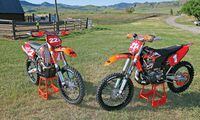
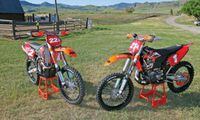
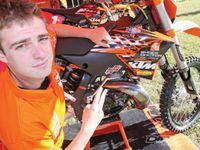
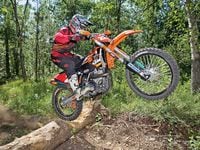
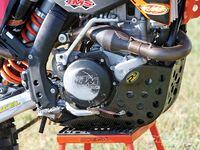
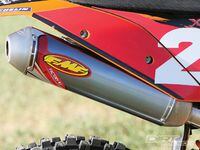
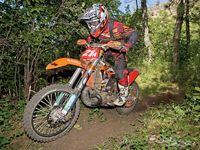
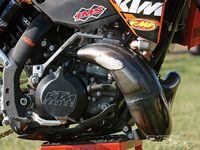
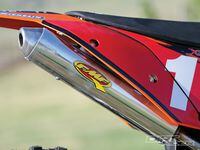
/cloudfront-us-east-1.images.arcpublishing.com/octane/M3QRBSQ4VFEVPKYTTM3OETVFBU.jpg)
/cloudfront-us-east-1.images.arcpublishing.com/octane/H3EMT5NJ5BDZPBBH27SW3ADQH4.jpg)
/cloudfront-us-east-1.images.arcpublishing.com/octane/XTROSHDZFJB5DIJYU2VF2REFIU.jpg)
/cloudfront-us-east-1.images.arcpublishing.com/octane/5A776WXBY5GAPDYFTTUEUZNIJA.jpg)
/cloudfront-us-east-1.images.arcpublishing.com/octane/NCYHFQ2S3BAT7EC7VDN2ONGRTU.jpg)
/cloudfront-us-east-1.images.arcpublishing.com/octane/XQORS527YFFT3MVI326EOEYJUI.jpg)
/cloudfront-us-east-1.images.arcpublishing.com/octane/TVDPP3TGMZHODFXASIFUM2KD34.jpg)
/cloudfront-us-east-1.images.arcpublishing.com/octane/EWDMR3DDTBBQPI7DQVZCLMRFAE.jpg)
/cloudfront-us-east-1.images.arcpublishing.com/octane/4XHHLVOUKFE3PDSWNSV4JJMGOE.jpg)
/cloudfront-us-east-1.images.arcpublishing.com/octane/5RLI3NQKQJA3LKKCQHRXQFTL6Q.jpg)
/cloudfront-us-east-1.images.arcpublishing.com/octane/3QCYJCI2RNBENIRWAKEOEKHFUM.jpg)
/cloudfront-us-east-1.images.arcpublishing.com/octane/UZHF7KAE7BFN7KU734ER7PPP3Q.jpg)
/cloudfront-us-east-1.images.arcpublishing.com/octane/XJFFFMRN6VEZ7CDNAGKWVPC3H4.jpg)
/cloudfront-us-east-1.images.arcpublishing.com/octane/RMC3CHWSHFAUJA2WJ2FVG4NBOA.jpg)
/cloudfront-us-east-1.images.arcpublishing.com/octane/WXEZV4WAYBERFKSRE5M7GQBW7A.jpg)
/cloudfront-us-east-1.images.arcpublishing.com/octane/LO3PZVGICFGJZBNUA2ORUSAUSE.jpg)
/cloudfront-us-east-1.images.arcpublishing.com/octane/UFHLTNOXLVARVLZV32M6ZJZV4Y.jpg)
/cloudfront-us-east-1.images.arcpublishing.com/octane/CTSWNU7SNNCC3LWB2KATYZ5AXY.jpg)
/cloudfront-us-east-1.images.arcpublishing.com/octane/IBNGAQWHJJF4TKSIQT54MTWRYQ.jpg)
/cloudfront-us-east-1.images.arcpublishing.com/octane/EAEWHFARGVGHFH4N4BDOSNBJSU.jpg)
/cloudfront-us-east-1.images.arcpublishing.com/octane/AZ7H35TQSZDKZCVM4S6CHERQEU.jpg)
/cloudfront-us-east-1.images.arcpublishing.com/octane/GYMIU7SMN5CWHP6QLFR6MVKEBU.jpg)
/cloudfront-us-east-1.images.arcpublishing.com/octane/B3CX7C4BFFCKBLDWHPQFACBH2E.jpg)
/cloudfront-us-east-1.images.arcpublishing.com/octane/6EIBG7NN4BH4FKDBCPCTLQL6FU.jpg)